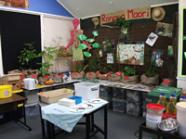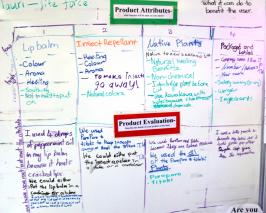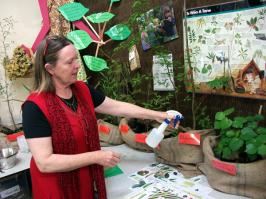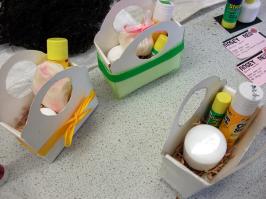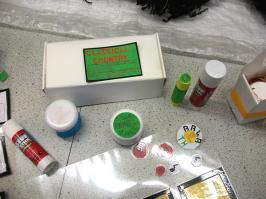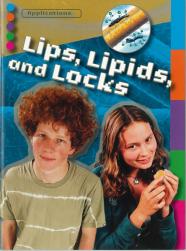Rongoā Māori in the technology learning area
This snapshot is a good example of local curriculum design with a context that is meaningful to the school community. It is an example of a culturally responsive unit that invites the use of mātauranga Māori and te ao Māori concepts.
Developing a new biotechnology course
Technology teacher Heather Bonk's decision to revamp the Year 7/8 biotechnology course at Tauranga Technology Centre led her to learning about Rongoā Māori. She set up a business and developed a new unit in which students could learn from the technological process she had followed.
How the technology centre is run
The Technology Centre
Students from 13 client schools attend the Technology Centre (at Tauranga Primary School) for a four-day technology block every term, as part of their two-year rotational programme. Each session is a whole-day (9 a.m. –3 p.m.) per week over four weeks, so a class will have, for example, four Mondays in a row during a term. In order to make the most of the time available, lunchtime is only 20 minutes but student enthusiasm is such that many ask to stay in during the morning tea or lunch break to continue working. "That's okay", Heather says, "As long as they've been outside and had something to eat. We're very fortunate having a programme like this. When we had different schools attending the morning and afternoon sessions a lot of valuable technology time was wasted coming in, setting up, and cleaning up before the next class."
Over the two years, students take materials outcomes (resistant and textiles), processed outcomes (biotechnology, food technology) and digital areas – computational thinking for digital technologies and designing and developing digital outcomes. The technological areas have always been integrated, with responsible students allowed to move freely between the rooms to source specific materials or expertise they require. For example, a student working in materials might require a fastening such as Velcro or a zip from the textiles area. In textile materials a hammer may be needed to attach eyelets to a product.
The students move to a different teacher and technological area every term, and in the fourth term they revisit one technological area. Heather says this does not pose a problem because of the integrated technologies, and there are new themes and challenges each term. The teachers also move from time-to-time to a different technological area. Heather has worked in all areas. Working as part of a team is not only what is required of students but it is also modelled by the technology teachers in planning and sharing expertise – one of the strengths of the Tauranga Technology Centre.
Students all work in mixed Year 7/8 classes on the same rather than a differentiated programme. Heather explains this is because student achievement level is not necessarily linked to their year level. The team assesses students by selecting achievement objectives from each strand of the technology learning area. The team tracks them as they move from technological area to technological area over their two years at the centre.
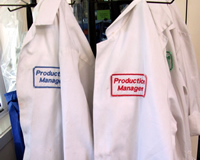
Coloured-coded white coats.
A shared theme
Each year the three teachers deliver their subjects based on a shared theme, in this case it was entrepreneurs. Biotechnology students were given a brief which asked them to develop bathroom products suitable for a new shop opening in Tauranga.
Tracking student group work
Heather's students work in groups of four. All the equipment they use is colour-coded for easy identification and monitoring. For example, if a green-labelled recipe book or saucepan is left out she knows the Green group hasn't tidied up properly.
During class discussions the Green group writes on the whiteboard with a green pen, and students initial their writing so that Heather can easily note who is contributing to the activity.
Upskilling in rongoā Māori
Heather has long had an interest in the ngahere (bush), especially around the Whanganui River where her family owns a property. She queried why exotic ingredients such as lavender and eucalyptus were being used rather than native plants. She wanted to teach her students the medicinal uses of these plants. Funded by Tauranga School, which promotes the value of lifelong learning, Heather enrolled in Robert McGowan's University of Waikato course on rongoā Māori. Heather says, she gained fantastic knowledge about the properties of native plants, the tikanga of rongoā Māori, the kawa (protocols) for harvesting plants, and met people of like-mind.
The process of learning to identify plants and learning of their medicinal properties was followed up with reading, listening to others, and lengthy walks in the ngahere. In sharing her knowledge of how to use and combine native plants, Heather points out to her students that some of the plants with the strongest medicinal properties are also the most poisonous and warns them of the danger in not correctly identifying a plant. "You know, you could make something quite dangerous if you don't know what you're doing." She says.
Using her new knowledge Heather made gifts and products to sell following the technological process.
Entrepreneurs in the classroom
Heather used her experience as the basis for a one-day unit on rongoā Māori, as part of the term-wide theme of entrepreneurs. She says this theme worked particularly well in Term 4 when students were assessed on planning for practice and outcome development and evaluation. Students often say, "We've done that," and she explains, "Yes. That's what it's all about".
Each day follows a similar routine: students are given their technology challenge for the day. They brainstorm ideas as a class and then develop their concepts in their groups. Having a whole day allows time for students to experiment, trial recipes, and modify before developing their final outcome. Throughout the day they record their discoveries, changes they could make for improvement, and evaluate product attributes. Students who finish early can continue noting their reflections and client comments, or do something extra such as a survey.
Learning skills
On day one the class extracted oil from either lavender, eucalyptus, or lemon. Students were given the equipment and, without any help, asked to extract the oil from their plant. Some knew what to do, some tried to mash the plant, and others thought lemon juice was the oil. After experimenting themselves, the students watched a video to see how professionals extract oil. The students then tried again using kettles, electric elements, tape, plant material, plastic, and ice to extract the oil. Heather notes that having the whole day makes a trial and error approach more easily achievable.
Planning for practice
In the rongoā Māori unit on day two, students were asked to design and develop an insect repellent using tītoki (a natural insecticide) and poroporo (which has anti-itching properties), and a lip balm based on mānuka honey and tea-tree oil. The class started with a brainstorming session on rongoā Māori, using the wall display of native trees and their properties as a discussion starter. The students then watched a documentary Earth Whisperers which, amongst other things, looks at how rongoā Māori was almost lost to New Zealanders.
Given the time it takes to gather plants and produce the oil Heather provides pre-prepared oil. She shows the students how to make lip balm and insect repellent but doesn't give quantities. The students need to experiment to find the best combination of ingredients. Throughout the day, Heather refers back to the processes she went through in developing her products.
Outcome development
The students work on tables outside as they grate, melt, and mould the wax for their lip balm and insect repellent. They are given bags of ice, so that they can test the consistency of their melted wax by cooling a spoonful in the ice. Students packaged their products in either a small pottle or a recycled glue stick. Those tempted to wind their balm up before it was set soon realised their mistake! Some coloured their products (using grated crayon). Others made striped lip balm, all of which looked fantastic, Heather says.
While the students are developing their products, Heather tells them about a group some years earlier which had created a food product to present to a chef. The students were excited that the chef would buy some of the food product to sell to his client. But the students were disappointed when he couldn't. Heather asks her class why that happened? She explains the group had forgotten to write the recipe down so they couldn't make it again. That's a big lesson, Heather says. It helps her students understand why they are writing things down as they trial recipes.
One of the great things about the rongoā Māori unit, says Heather, is enhancing the link between home and school. Students share stories about how their families successfully use medicinal plants at home.
On day three the students developed bath products, such as bath bombs. They modify existing recipes to make their own version. The class looked at the properties of different essential oils. Students had to consider which to use in their products so that, for example, they didn't use a stimulant for something designed as a relaxing product. Students can use lots of oil rather than the requisite few drops despite safety warnings, so Heather buys cheap brands to save her budget. She says, the issue is reduced because group members are allocated roles. The roles in the groups are production manager, quality controller, resource manager, and marketing manager. The quality controllers usually watch that not only their group but the others aren't wasting supplies!
Evaluation
Day four is allocated as Entrepreneurs Day. Parents visit at lunchtime to see what the students have been working on and try samples of the food and biotechnology outcomes. In the morning Heather's students finished any outstanding tasks. They developed their labels, brochures, business cards, and packaging. Heather says that while giving the groups scope for making their own decisions, she also directs them. This is so that they're not spending too much time on particular aspects, such as making a box for their product.
The students write their own report for the term after the parent visit. They include photos of themselves involved in the development processes. The students evaluate the level at which they have worked in relation to the achievement objectives – students indicate as to whether they were working at spectator, apprentice, or expert level.
Heather explains to them that one of her assessments of their level is based on what they tell her they have learnt:
- "I've discovered how to get oil from plants" = spectator
- "I've discovered how to get oil out of plants by boiling it and allowing the steam to go through so the oil collects in a jar" = apprentice
- "I've discovered how to get oil from plants by putting plant material in the pot, heating it up so the steam carries the oil through the tube and is cooled by the ice, which is called condensing, into the jar where it settles on top" = expert.
Further resources
Article in Connected with discussion starters in the technology learning area: "The Science of Rongoā", Connected - Fact or Ficion?, level 3, January 2015
Student showcase: Kawakawa leaf extract
Anyone interested in teaching a similar biotechnology unit will find two of the Ministry of Education's Applications series journals useful resources.
The Gift of Rongoā by Shirley Cormack
(Dewey No 610.8999442, ISBN 0 7903 0847 9, Item No 30847)
-
Lips, Lipids, and Locks
(Dewey No 668.55, ISBN No 0 7903 0849 5, Item No 30849)
The above items can be ordered free of charge through Down the back of the chair by phoning 0800 660 662 with your school's login password.

